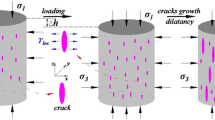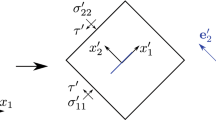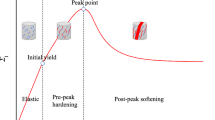Abstract
This paper captures the frequently encountered strain localization of brittle rocks in laboratory compression experiments under moderate confining pressures generally ranging from 10 to 60 MPa. The plastic volumetric strains are related to particle dislocations in shear bands strongly constrained by relatively undeformed neighboring materials. Accordingly, the dilatant behavior of shear bands, analogous to a rock joint shearing, is predicted by introducing a multiple-asperity joints model. By imposing the model, the dislocation of grain particles in bands is abstracted by an uneven interface shear to reflect admitted volumetric strain behavior. It also highlights key issues associated with the bands, i.e., the width, the boundary conditions and non-uniform grain sizes within the bands. To tackle these problems, appropriate hypotheses are further made to simplify analytical procedures. The solution can quantify triaxial stress–strain relations with the least number of model parameters. A comparison between predictions and published experimental data is claimed to be satisfactory.










Similar content being viewed by others
Data availability statement
Some or all data, models or code generated or used during the study are available from the corresponding author by request (the data in the graph and the code of calculation).
Abbreviations
- H :
-
Height of prismatic specimen
- D :
-
Diameter of cylinder specimen
- W :
-
Equivalent width of cylinder sample
- ε :
-
Global apparent strain
- ε e :
-
Elastic strain
- ε p :
-
Permanent strain
- E :
-
Elasticity modulus
- ν:
-
Poisson’s ratio
- σ 1 :
-
Major principal stresses
- σ 3 :
-
Minor principal stresses
- W s :
-
Localized width of shear bands
- R :
-
Radius of grains
- r :
-
Radius of a cylindrical cavity.
- L :
-
Total length of the primary joint profile
- θ :
-
Inclination of asperities
- l i :
-
Chord length of the ith asperities
- l min :
-
Minimum chord length of asperity
- l max :
-
Maximum chord length of asperity
- n :
-
Total number of asperities
- \(\xi_{i}^{cr}\) :
-
Critical shear displacement for ith asperity
- c :
-
Cohesion of rocks
- φ :
-
Internal friction angle of rocks
- φ b :
-
Base friction angle of rocks
- K :
-
Normal spring stiffness
- ξ :
-
Displacement of the interface
- l cr :
-
Critical chord length of failed asperities
- τ i ,int :
-
Local shear strength of intact asperities
- m :
-
Number of failed asperities
- τ i ,res :
-
Local shear strength of failed asperities
- φ r :
-
Residual frictional angle of rocks
- A :
-
Nominal area of the joint
- τ :
-
Global shear strength across the total joint
- i cr :
-
Index of the biggest failed asperity
- ψ :
-
Dilatancy angle of rocks
- ω :
-
The angle of shear band with respect to the horizontal
References
Arthur JRF, Dunstan T, Al-Ani Q, Assadi A (1977) Plastic deformation and failure of granular media. Géotechnique 27(1):53–74
Barton N, Choubey V (1977) The shear strength of rock joints in theory and practice. Rock Mech 10(1):1–54
Boresi AP (1965) Elasticity in engineering mechanics. Prentice Hall Inc., Englewood Cliffs, New Jersey
Bésuelle P, Desrues J, Raynaud S (2000) Experimental characterisation of the localisation phenomenon inside a Vosges sandstone in a triaxial cell. Int J Rock Mech Min Sci 37(8):1223–1237
De Borst R, Mühlhaus HB (1992) Gradient-dependent plasticity: formulation and algorithmic aspects. Int J Numer Meth Eng 35(5):521–539
Desrues J (1984) La localisation de la déformation dans les matériaux granulaires. Université Joseph-Fourier-Grenoble I, La Tronche
Divakar MP, Fafitis A (1992) Micromechanics-based constitutive model for interface shear. J Eng Mech 118(7):1317–1337
Donath FA, JrLS F (1971) Dependence of strain-rate effects on deformation mechanism and rock type. J Geol 79(3):347–371
Gao G, Meguid MA, Chouinard LE (2020) On the role of pre-existing discontinuities on the micromechanical behavior of confined rock samples: a numerical study. Acta Geotech 15(12):3483–3510
Haque A, Kodikara J (2012) A simplified analytical model for predicting the shear behaviour of regular triangular rock/concrete joints under constant normal stiffness. Géotechnique 62(2):171–176
He C, Okubo S, Nishimatsu Y (1990) A study on the class II behavior of rock. Rock Mech Rock Eng 23(4):262–273
Hill R (1958) A general theory of uniqueness and stability in elastic-plastic models. J Mech Phys Solids 6(3):236–249
Hobbs BE, Mühlhaus HB, Ord A (1990) Instability, softening and localization of deformation. Geol Soc Lond Spec Publ 54(1):143–165
Hudson JA, Crouch SL, Fairhurst C (1972) Soft, stiff and servo-controlled testing machines: a review with reference to rock failure. Eng Geol 6(3):155–189
Indraratna B, Haque A (2000) Shear behaviour of rock joints. CRC Press, Boca Raton
Indraratna B, Oliveira DA, Brown ET, De Assis AP (2010) Effect of soil–infilled joints on the stability of rock wedges formed in a tunnel roof. Int J Rock Mech Min Sci 47(5):739–751
Johnston IW, Lam TSK (1989) Shear behavior of regular triangular concrete/rock joints-analysis. J Geotech Geoenviron Eng 115(5):711–727
Johnston IW, Lam TSK, Williams AF (1987) Constant normal stiffness direct shear testing for socketed pile design in weak rock. Géotechnique 37(1):83–89
Kolymbas D (2007) Incompatible deformation in rock mechanics. Acta Geotech 2(1):33–40
Kolymbas D (2009) Kinematics of shear bands. Acta Geotech 4(4):315–318
Ladanyi B, Archambault G (1970) Simulation of shear behaviour of a jointed rock mass. Rock Mechanics, W. H. Somerton, ed., Proc. 11th U.S. Symp. On Rock Mechanics, Berkeley, Calif: 105–125
Li C (1995) Micromechanics modelling for stress-strain behaviour of brittle rocks. Int J Numer Anal Meth Geomech 19(5):331–344
Li X, Konietzky H, Li X, Wang Y (2019) Failure pattern of brittle rock governed by initial microcrack characteristics. Acta Geotech 14(5):1437–1457
Lobo-Guerrero S, Vallejo LE (2005) DEM analysis of crushing around driven piles in granular materials. Géotechnique 55:617–623
Mahmutoğlu Y (2006) The effects of strain rate and saturation on a micro-cracked marble. Eng Geol 82(3):137–144
Masuda K (2001) Effects of water on rock strength in a brittle regime. J Struct Geol 23(11):1653–1657
Menéndez B, Zhu W, Wong TF (1996) Micromechanics of brittle faulting and cataclastic flow in Berea sandstone. J Struct Geol 18(1):1–16
Mühlhaus HB, Vardoulakis I (1987) The thickness of shear bands in granular materials. Géotechnique 37(3):271–283
Patton FD (1966) Multiple modes of shear failure in rock. In: Procced. 1st Cong. Int. Soc. Rock Mech., Lisbon 1, 509–513
Peng SY, Ng CWW, Zheng G (2014) The dilatant behaviour of sand–pile interface subjected to loading and stress relief. Acta Geotech 9(3):425–437
Pettijohn FJ, Potter PE, Siever R (2012) Sand and sandstone. Springer, Berlin
Rudnicki JW, Rice JR (1975) Conditions for the localization of deformation in pressure-sensitive dilatant materials. J Mech Phys Solids 23(6):371–394
Saeb S, Amadei B (2000) Modelling rock joints under shear and normal loading. Int J Rock Mech Min Sci 29(3):267–278
Seidel JP, Haberfield CM (2002) A theoretical model for rock joints subjected to constant normal stiffness direct shear. Int J Rock Mech Min Sci 39(5):539–553
Skinas CA, Bandis SC, Demiris CA (1990) Experimental investigations and modelling of rock joint behaviour under constant stiffness. Proc Int Conf Rock Joints Loen 301–308
Sokolovskii VV (1965) Statics of granular media. Pergamon Press, New York
Stow DAV (2005) Sedimentary rocks in the field: a color guid. Gulf Professional Publishing, Houston
Trivedi A (2010) Strength and dilatancy of jointed rocks with granular fill. Acta Geotech 5(1):15–31
Vardoulakis I (1980) Shear band inclination and shear modulus of sand in biaxial tests. Int J Numer Anal Meth Geomech 4(2):103–119
Vermeer PA (1990) The orientation of shear bands in biaxial tests. Géotechnique 40(2):223–236
Wernick E (1978) Skin friction of cylindrical anchors in noncohesive soils. In: Proceedings symposium on soil reinforcing and stabilising techniques in engineering practice. Sydney, Australia, 201–219
Wong TF, Baud P (2012) The brittle-ductile transition in porous rock: a review. J Struct Geol 44:25–53
Yang SQ, Jiang YZ, Xu WY, Chen XQ (2008) Experimental investigation on strength and failure behavior of pre-cracked marble under conventional triaxial compression. Int J Solids Struct 45(17):4796–4819
Yang SQ, Ranjith PG, Gui Y (2015) Experimental study of mechanical behavior and X-ray micro CT observations of sandstone under conventional triaxial compression. Geotech Test J 38(2):179–197
Zhang P, Li N, Li XB, Nordlund E (2009) Compressive failure model for brittle rocks by shear faulting and its evolution of strength components. Int J Rock Mech Min Sci 46(5):830–841
Zhao Y, Gao Y, Wu S, Chen L, Zhang C (2021) Experimental and numerical study of failure characteristics of brittle rocks with single internal 3D open-type flaw. Acta Geotech 16:3087–3113
Zhao H, Xiao Y, Zhao MH, Yin PB (2017) On behavior of load transfer for drilled shafts embedded in weak rocks. Comput Geotech 85:177–185
Zhao H, Zhou S, Zhao MH, Shi C (2018) Statistical micromechanics-based modeling for low-porosity rocks under conventional triaxial compression. Int J Geomech 18(5):04018019
Zhou GL, Tham GL, Lee PKK, Tsui Y (2001) A phenomenological constitutive model for rocks with shear failure mode. Int J Numer Anal Meth Geomech 25(4):391–414
Acknowledgements
This research is a part of the work carried out by grants from the National Natural Science Foundation of China (Nos. 51978255 and 52108317).
Author information
Authors and Affiliations
Corresponding author
Additional information
Publisher's Note
Springer Nature remains neutral with regard to jurisdictional claims in published maps and institutional affiliations.
Rights and permissions
Springer Nature or its licensor holds exclusive rights to this article under a publishing agreement with the author(s) or other rightsholder(s); author self-archiving of the accepted manuscript version of this article is solely governed by the terms of such publishing agreement and applicable law.
About this article
Cite this article
Zhao, H., Hou, J., Peng, W. et al. A conceptual modeling on the behavior of strain localization for brittle rocks. Acta Geotech. 17, 5239–5251 (2022). https://doi.org/10.1007/s11440-022-01652-z
Received:
Accepted:
Published:
Issue Date:
DOI: https://doi.org/10.1007/s11440-022-01652-z




